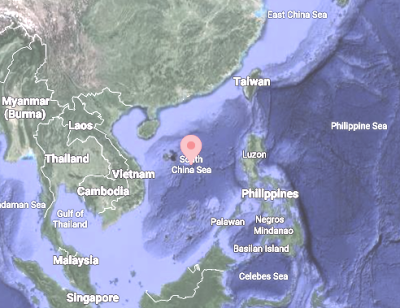 |
| South China Sea |
Mami Yamazaki
Department of International Studies
Open University of Japan
Chiba, Japan
E-mail: info@globalculturz.org
Recently Chinese People's Liberation Army (Naval) along with Chinese Coast Guard conducted a military drill in South China Sea. Chinese Government has a big aspiration to become a global power. This aspiration is a result of manifold achievements in the sector of economy. The US also sent two aircraft carriers The USS Nimitz and USS Ronald Reagan to do operations and make sure free navigation in Indo-Pacific region. Though the US Naval Force has denied any kind of retaliation; apparently this exercise was to check and balance the activities of Chinese army.
Around $3 trillion of trade passes through South China Sea, each year. This naturally rich region became a bone contention among Chinese neighbors viz Taiwan, Brunei, Malaysia, the Philippines, and Vietnam claim territory in the South China Sea. Indonesia is also concerned about the Chinese exercises. China began to build seven artificial island in the area in 2010. In 2016 these construction and overall activities of the Chinese Government were termed ‘illegal’ by an international court. The Permanent Court of Arbitration, based in The Hague, Netherlands, is said to give a decision on 12 July in matter of the case files by the Philippines.
China has been involved in military altercations along with Japan and India too. Indian army personnel and Chinese military men were killed and the tension is still high along with Line of Actual Control (LAC) an imaginative boarder line not accepted by either side. Narendra Modi, PM of India paid a surprise visit to border Leh to boost the morale of their army. It is not yet known if there is any progress to normalize the situation through diplomatic channel. Chinese navy vessels frequently navigate near Senkaku Islands of Japan. The Japanese government has recorded many protests for these unwanted navigation activities but there is hardly any improvement in Chinese mindset.
In the meanwhile, Hong Kong is severely disturbed by pro-democratic protests. Various autocratic laws are imposed on the citizens curbing freedom of speech. A number of sanctions have been imposed by Global community taking into the considerations of Chinese adamant attitude towards Hong Kong. China faced the heat of Covid-19 pandemic. The economy was affected. During this period Hong Kong was peaceful because of lockdown. But the protests erupt again.
Just look the history of Chinese expansionism. The autonomous region of Tibet was captured in 1958. Now, people of mainland China injected in the social system of Tibet to ‘naturalize’ the area. The Tibetan leader Dalai Lama is still living in an asylum in India. Since WW-II China was eying to weaken the neighboring countries including Japan. Almost all of its neighbors are engage with one or other type dispute. South China Sea is well contested territory now-a-days. The Permanent Court of Arbitration, Netherlands, is going to issue a decision on July 12 on a petition made by Philippines challenging Chinese claims. However China continuously boycotted the proceedings and continued its activities. The US and European Union have shown their concerns on several occasions regarding ‘unlawful’ activities by Chinese forces. The US president Donald Trump has taken a hard stand against Chinese goverment and categorically blame to spread the Coronavirus globally. Indian PM, Modi, indirectly advised China to focus on developmentalism and not on expansionism. The PM of Japan, Mr. Abe Shinzo, has shown his hesitation to meet Mr. Xi and probably the later’s re-scheduled visit to Japan will be canceled. In this scenario, the Chinese dream to become a global power remains dim.
